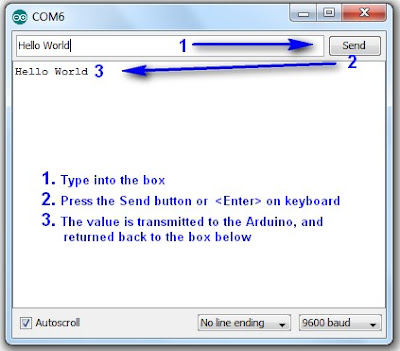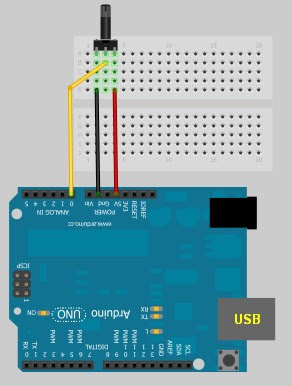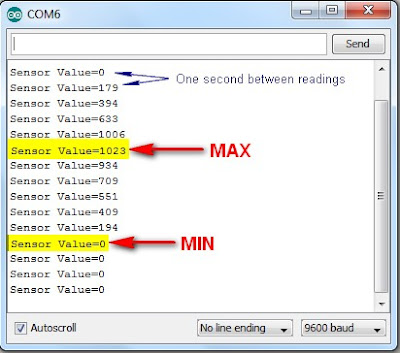This Tutorial is progressive and will be updated from time to time. The goal is to start from a very basic form of Arduino Serial communication, and progressively add or improve components so that we can ultimately transmit data from one computer to another using an XBee.
Please note: I am not an expert, but am happy to share what I have learned. The Arduino forums are a great place to ask questions, feel free to link to this blog (if required).
Let us begin.
Stage 1: ECHO ECHO
Parts Required:
- Computer
- USB cable
- Arduino UNO (or equivalent)
- Arduino IDE
The following code will make the Arduino ECHO anything you send to it. Therefore, if you type a 3, the Arduino will send back a 3. If you type a letter F, the Arduino will send back a letter F.
Enter the following code into your Arduino IDE and upload it to your Arduino.
Arduino Sketch
1 | /* Simple Serial ECHO script : Written by ScottC 03/07/2012 */ |
Instructions
1. Once the Arduino sketch has been uploaded to the Arduino. Open the Serial monitor, which looks like a magnifying glass at the top right section of the Arduino IDE. Please note, that you need to keep the USB connected to the Arduino during this process, as the USB cable is your communication link between your computer and the Arduino.
3. Please note that we are using Serial.write(byteRead); on line 18 to get the Arduino to ECHO the message back to you on your computer.
Things to Try
1. Delete lines 16 to 18, and replace them with the following line :
Serial.write(Serial.read());
This essentially eliminates the byteRead variable in the sketch above. But we will be using it later on, so once you have tested it out, put the code back together as originally displayed.
--------------------------------------------------------------------
2. Replace line 18 with a Serial.println instead of Serial.write
Serial.println(byteRead);
Once uploaded, type 1 <enter> 2 <enter> 3 <enter> into the Serial Monitor.
You should see:
49
50
51
Serial.print and Serial.println will send back the actual ASCII code, whereas Serial.write will send back the actual text. See ASCII codes for more information.
--------------------------------------------------------------------
3. Try typing in numbers like 1.5 or 2.003 or -15.6 into the Serial Monitor using Serial.write and Serial.print or Serial.println commands as described before.
You will notice that the decimal point transmits as a number using Serial.print or Serial.println, and will transmit as a decimal point when using Serial.write
STAGE 2: Delimiters
How do you handle 2 or more numbers when sending or receiving?
Let us say that you have number pairs that you want the Arduino to interpret. How do you separate the numbers? The answer is Delimiters.
You may be familiar with CSV (comma separated value) files, where each field is separated by a comma (,). The comma is a useful way of separating or grouping information.
Lets say you have the following stream of numbers:
12345678910
How will your Arduino know if this is a single number, or a series of numbers?
Eg:
12,34,56,78,91,0
123,456,78,910
1,2,3,4,5,6,7,8,9,10
12345678910
The comma delimiters help to identify how the numbers should be interpreted.
In the echo example in Stage 1 above, you would have noticed that when we used Serial.print(byteRead); that the values displayed one after another in a similar fashion to 12345678910.
You would have also noticed that Serial.println(byteRead); provided a line break between each value sent. And depending on the numbers sent, it could have looked like this:
12
34
56
78
91
0
The Serial.println() function essentially uses a line feed to separate the values being sent. This line break can be used as a delimiter, but we will look at that later on. For now we will concentrate on using a comma (,).
We will now get the Arduino to "listen" for the comma to help it identify a new number.
According to the ASCII code site, a comma is equal to byte code 44. So when the Arduino reads a byte code that is equal to 44, we will get it to print a line feed.
Enter the following sketch into your Arduino IDE and upload it to your Arduino.
Arduino Sketch
1 | /* Simple Serial ECHO script : Written by ScottC 04/07/2012 */ |
Instructions
1. Once the code has been uploaded to the Arduino, open the Serial Monitor once again and type the following sequence of numbers:
1 <enter> 2 <enter> 3 <enter>
You should see the Serial monitor display the following number: 123
--------------------------------------------------------------------
2. While still in the serial monitor, type the following:
, <enter> 1 <enter> , <enter> 2 <enter> , <enter> 3 <enter> ,
Please note the commas between each numerical entry. You should now see a pattern like this:
1
2
3
--------------------------------------------------------------------
3. While still in the serial monitor, type the following:
12,23,34,45, <enter>
Please note the commas between each numerical entry. You should now see a pattern like this:
12
23
34
45
You will notice that the commas have been replaced by line feeds, and each number should display on a new line.
--------------------------------------------------------------------
4. While still in the serial monitor, type the following:
1,,2,,3, <enter>
You should see the following pattern:
1
2
3
So hopefully that explains the concept of delimiters and how they can be used to separate a stream of numbers, no matter how long it takes to get to the Arduino. We used an IF-statement to listen for the comma, but we could have used any other delimiter provided we knew the byte code.
We did not identify how to send delimiters FROM the Arduino, but we will get to that I promise. It is not that hard, and uses a similar principle. I am sure you can work it out, if not, stay tuned.
STAGE 3: Arduino Maths: Simple addition
In this stage, we are going to get the Arduino to do simple maths. We will send it two integers (or whole numbers), and the Arduino will do the hard work and send us the answer in no time at all.
This might seem like a simple task, but when you send a number like 27 to the Arduino, it does not receive the number 27. It receives 2 and then 7 in byte form. In other words, the Arduino will see the byte codes 50 and then 55 as per the ASCII table on this page.
One way to convert this byte code back to a 2 and a 7 is to subtract 48 from each byte received, providing the byte is in the range 48 to 57 inclusive (which equates to the numbers 0-9).
We are not done yet. We then need to join these numbers to make 27.
Step1: Subtract 48 from the bytes received, only if the bytes are in the range 48 to 57.
Example: 50 - 48 = 2
55- 48 = 7
Step2: Multiply the previous number by 10, before adding the most recent byte received.
Example: (2 x 10) + 7 = 27
If we have a number like 1928, then we would create this number using the following calculation
1 = 1
(1 x 10) + 9 = 10 + 9 = 19
(19 x 10) + 2 = 190 + 2 = 192
(192 x 10) + 8 = 1920 + 8 = 1928
Step3: Use a "+" sign as a delimiter so that the Arduino can move onto the Second number
Step4: Capture the second number as per Step2. An "=" sign will tell the Arduino that it has reached the end of the second number, and to proceed to step 5.
Step5: Add the 2 numbers together and send back the answer.
The following code will carry out the 5 steps above.
Enter the following sketch into your Arduino IDE and upload it to your Arduino.
Arduino Sketch
1 | /* Simple Serial ECHO script : Written by ScottC 05/07/2012 */ |
The above code was formatted using this site
Instructions
1. Once the code has been uploaded to the Arduino, open the Serial Monitor once again and type the following sequence:
1+2= <enter>
You should get the following message sent back to Serial Monitor
1+2=3
Things to Try
1. Enter this sequence:10 <enter>
+ <enter>
10 <enter>
= <enter>
Result: 10+10=20
--------------------------------------------------------------------
2. Enter this sequence:
10 <enter>
20 <enter>
+5= <enter>
Result: 1020+5=1025
--------------------------------------------------------------------
3. Enter this sequence:
10+20+30= <enter>
Result: 10+2030=2040
I have specifically written this script to add two whole numbers together. If you start to introduce more complicated calculations, the results become unpredictable.
--------------------------------------------------------------------
4. Enter this sequence:
1.2+1.0= <enter>
Result: 12+10=22
Once again, I have only designed this script to handle whole numbers. Therefore, decimal points are ignored.
--------------------------------------------------------------------
5. Enter this sequence:
-5 + 10= <enter>
Result: 5+10=15
This script ignores the negative sign, and treats the -5 as a positive 5.
I have done this on purpose. I wanted to show you how the Arduino reads numbers from the com port, and how easy it is to exclude vital functionality in your code. I have kept this script simple, however, if you wanted to, you could make the Arduino deal with each of the above situations and more. Multiplication, division and subtraction is handled in the same way.
This is the last thing I want you to try before we go to the next stage:
6. Enter this sequence:
2147483646+1= <enter> Result: 2147483646+1=2147483647
2147483647+1= <enter> Result: 2147483647+1=-2147483648
Note that the maximum size of a "long" number is 2147483647. If you add one to this number, the result is equal to the minimum size of a "long" which is -2147483648.
STAGE 4: Sending doubles to Arduino : The double doubler
Now we get to some tricky business. Sending and receiving Doubles (to and from) the Arduino.
Up until now, I have tried to keep it simple using whole numbers, but there will come a time when you will want to send a fraction of a number through the Serial line.
Up until now, I have tried to keep it simple using whole numbers, but there will come a time when you will want to send a fraction of a number through the Serial line.
To test our program, we will want to send a very small number to the Arduino, multiply the number by 2, and return it back.
Our final test is to try a number like : 0.000001
and then a number like: 123.321
IMPORTANT NOTE: When the Arduino sends a float or a double through the COM port using Serial.print() or Serial.println(), it will automatically send the number to 2 decimal places.
A number like 1.2345 will appear as 1.23, and a number like 1.9996 will appear as 2.00
To demonstrate this, we will get the Arduino to send these floats/doubles to the Serial Monitor.
Enter the following sketch into your Arduino IDE and upload it to your Arduino.
Arduino Sketch
1 | /* Stage 4: Simple Transmission of a Double |
When you open the Serial monitor (after you have uploaded the sketch above), you will notice the following output:
myDub1 (1.2345) : 1.23
myDub2 (1.9996) : 2.00
The blue text represents the string (or array of characters) being sent using lines 19 and 21.
The red text represents the actual double being sent using lines 20 and 22.
You will notice that myDub2 rounds to 2.00. This may or may not be what you want.
If you wish to increase the number of decimal places, then you will need to change lines 20 and 22 to the following:
20 Serial.println(myDub1,4);
22 Serial.println(myDub2,4);
The number 4 highlighted in red, indicates the number of decimal places you wish to send.
Try it ! And try changing this number to something bigger or smaller.
---------------------------------------------------------------------------------------------------
Ok - now that we understand this little Serial.print(double,decimals) trick, we will now get the Arduino to echo back a Double.
Before we jump in, perhaps we should try and map out our strategy. For this we will choose a simple decimal to make it easier. So in this example, we will choose 0.1
Once we get this working, we can then do our final test (as mentioned above).
If we send 0.1 to the Arduino, it will read the following byte code
48 0
46 .
49 1
We can use the decimal point as a delimiter.
We will use the following 5 steps to echo the double back to the Serial Monitor:
We will use the following 5 steps to echo the double back to the Serial Monitor:
Step1: Arduino collects all numbers before the decimal point using the same technique as in Stage3.
Step2: When the Arduino receives byte code 46, it will go into decimal mode.
Step3: The Arduino will collect numbers after the decimal point using a similar technique to step1.
Step4: Use maths to create the double, and then multiply it by 2
Step5: Display the doubled Double value in the Serial monitor.
Enter the following sketch into your Arduino IDE and upload it to your Arduino.
Arduino Sketch
1 | /* Simple Serial ECHO script : Written by ScottC 06/07/2012 */ |
The above code was formatted using this site
Things to Try
1. Type the following into the serial monitor:
1.2= <enter> Result: 1.2 x 2 = 2.4
Make sure that you type the equal sign (=) before you press enter, otherwise the Arduino will not know that you are finished, and will not send anything back.
--------------------------------------------------------------------
2. Type the following into the serial monitor:
100.001= <enter> Result: 100.001 x 2 = 200.002
You will notice that the Arduino is formatting the decimal to the SAME number of decimals as that entered.
This is controlled by the variable: numOfDec.
---------------------------------------------------------------------
3. Now for our final test: Type the following into the serial monitor:
0.000001= <enter> Result: 0.000001 x 2 = 0.000002
First test: PASSED
----------------------------------------------------------------------
4. Type the following into the Serial monitor for our last test:
123.321= <enter> Result: 123.321 x 2 = 246.642
Second test: PASSED
-----------------------------------------------------------------------
BEWARE: While everything looks perfect, let me tell you that it isn't. But hopefully this code will help you get on the right track. If you decide to type in a number like 123123.111222, you will not get the answer you expected.
I have found that this program will work if the amount of numbers before and after the decimal point are less than about 9. Eg. 1234.1234 will produce the right result.
However, 11111.2222 will NOT, because there are 9 numbers represented.
I think this has something to do with the memory allocated to a double, but I am not sure.
I don't know if people work with these types of numbers, but I am sure there is a workaround, and I am sure someone out there can work it out. I don't personally need this kind of precision, but thought to mention it just in case you do.
-----------------------------------------------------------------------
-----------------------------------------------------------------------
STAGE 5: Sending sensor data to the Serial Monitor
We know the Arduino is very good at copy-Cat games, how about getting the Arduino to send us some data from one of our sensors. We will use the Serial Monitor to view the sensor data.
Disconnect the USB cable, and hook up one of your favourite analog sensors to your Arduino. For simplicity, I am going to hook up a potentiometer as per the Fritzing sketch below.
Parts Required
- Arduino UNO (or equivalent)
- Computer with USB cable
- Breadboard
- Potentiometer
- 3 Wires
Arduino Fritzing Sketch
Once you have attached your sensor to the board, plug your USB cable into the Arduino, and upload the following sketch.
Arduino Sketch
1 | /* Stage 5: Send Sensor Value to Serial Monitor |
1. Open the Serial monitor and watch the readings change depending on the input conditions. In my case, by turning the potentiometer from left to right, I get an output similar to the picture below.
As per the Arduino reference site, AnalogRead returns an integer between 0 and 1023. You can see this is true based on the picture above. But what if we do not want a value between 0 and 1023. Let us say we want a value between 0 and 100?
You would have to use the map function. We will do it by changing line 13 to this:
13 sensorVal = map(analogRead(A0),0,1023,0,100);
The map function is quite a cool function, and good fun to play around with. So here are some things to try.
Things to Try
1. Change line 13 to the following, upload to the Arduino
and then open the Serial Monitor to see the effect.
Trial 1:
13 sensorVal = map(analogRead(A0),0,1023,100,0);
Trial 2:
13 sensorVal = map(analogRead(A0),0,1023,0,1000);
Trial 3:
13 sensorVal = map(analogRead(A0),200,800,0,100);
In Trial 1: We see that the values have been inverted. Instead of ranging from 0 up to100, they now go from 100 down to 0.
In Trial 2: The analog readings are now mapped to a range of 0 up to 1000.
In Trial 3: The analog readings that range from 200 to 800 are mapped to a range of 0 to 100. Therefore if the analog readings drop below 200, we will end up with a negative value for sensorVal.
If the analog readings go above 800, we will end up with a value greater than 100. For this particular example, my readings actually range from -33 to 137.
Therefore an Analog reading of 0 = -33
Analog reading of 200 = 0
Analog reading of 800 = 100
Analog reading of 1023 = 137
----------------------------------------------------------------------------------
What if we don't want the output to go beyond our intended limits of 0 to 100?
Then you would have to use the constrain function. This essentially trims the reading range of the sensor, and sets a minimum and maximum value.
Replace line 13 with the following code:
13 sensorVal = constrain(map(analogRead(A0),200,800,0,100),0,100);
Therefore an Analog reading of 0 = 0
Analog reading of 100 = 0
Analog reading of 200 = 0
Analog reading of 800 = 100
Analog reading of 955 = 100
Analog reading of 1023 = 100
Analog values between 200 and 800 will produce a result between 0 and 100.
-------------------------------------------------------------------------------------
If you wish to continue with this tutorial (stage 6 and above), please follow this link: Serial Communication Stage 6 and above
![]()
If you like this page, please do me a favour and show your appreciation :
Visit my ArduinoBasics Google + page.
Follow me on Twitter by looking for ScottC @ArduinoBasics.
I can also be found on Pinterest and Instagram.
Have a look at my videos on my YouTube channel.
![]()
Description: Simple Arduino Serial Communication Rating: 3.5 Reviewer: Unknown ItemReviewed: Simple Arduino Serial Communication




 you are reading post about
you are reading post about 
0 comments:
Post a Comment